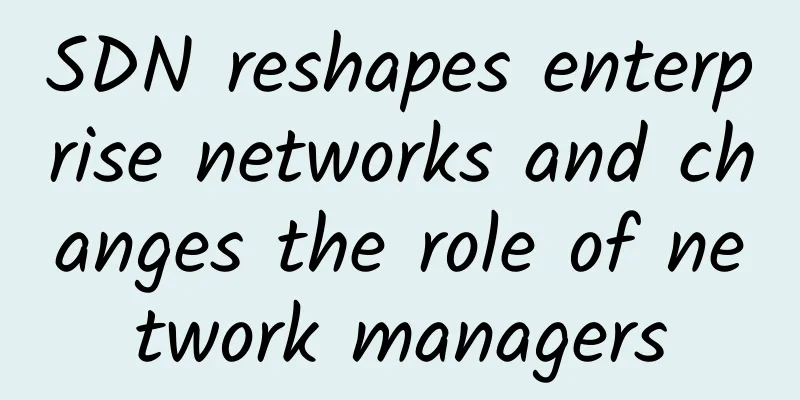SDN reshapes enterprise networks and changes the role of network managers

|
We have seen that many operators have significantly improved their flexibility and shortened the time to market for new services after implementing SDN applications. Many companies in the industry are also considering embracing this new technology to gain additional benefits. However, it is not just an example of technological change, it also means a change in corporate culture. “The traditional network administrator only cares about the hardware and the network operating system,” said Clive Longbottom, senior analyst at Quocirca. “They look at how packets are moving based on aspects like the rules applied to routers and switches. They might look up a little bit and look at firewalls and other edge devices in the network, but they prefer to use the rules that have been defined to handle the business.”
This old way of managing networks has been around for a long time. The network is arguably the most important element of the infrastructure, and network administrators have always been very focused on the hardware and making sure the systems are running, otherwise it would be difficult and complicated for the business to operate.” "SDN network administrators have to get more involved in platform management," Longbottom said. "Those precious packets of data processed at the device level by application-specific integrated circuits [ASICs] and central processing units [CPUs] can be upgraded to servers that operate on data in a more granular and detailed manner. All of a sudden, network administrators have to understand the servers and start to understand the business that the enterprise is running." Integrate SDN into your company culture IT vendors are keen to convey the idea that virtualized networks will bring benefits to enterprises to their customers, but this cannot change the reality that traditional network managers remain "silent" about this. “The benefits of SDN have been widely discussed,” said Scott Sneddon, senior director of SDN and virtualization at Juniper Networks. “These benefits enable network managers to deliver more agile services through automation, abstraction and tight integration with devops and cloud operations tools.” "But to achieve the best possible benefits, IT departments need to focus on their corporate culture. Network management teams need to work closely with cloud teams to eliminate the gaps that have existed in the past." Sneddon said traditional delegation of all network management and configuration tasks creates delays in the implementation of new services and severely impedes agility. But even though this means greater internal organizational adjustments, these companies can still benefit from the new tools. "These businesses bring cross-functional teams together, with network management, cloud management, security and application development teams all sitting at the table, creating a culture of knowledge sharing and collaboration," Sneddon said. User Experience While SDN has not yet been implemented in every enterprise, some industries are more willing to implement its application sooner rather than later. The education industry is one example. After migrating its network to Avaya Fabric Connect, Avaya’s SDN system, the University of London increased the capacity and resiliency of its network while reducing the time it takes to deploy network upgrades. The university's Information Technology department provides a network that must accommodate 5,000 Wi-Fi users and 6,000 wired connections at peak times for approximately 17,000 students, 2,000 staff and 600 lecturers in more than 40 faculties, as well as a number of additional specialist centres. So the benefits of moving the network to SDN and more agile networks are clear. However, this is a university with a long history - dating back to the 1890s - and it's no surprise that its network center has a lot of legacy hardware, as well as traditional network managers who are getting older. Claire Priestley, the school's director of information technology, said SDN was the evolution of the networking revolution. “The first step was to introduce fabric networking to our main campus and data center networks,” she said. “Bottlenecks and congestion in our network traffic disappeared overnight, and we saw our recovery times drop from five minutes before the implementation to 20ms.” “From a security perspective, this is a huge step forward. As a university, we have over 17,000 students and, therefore, over 17,000 potential hackers. We now have the ability to create fully isolated and secure networks in minutes, which revolutionizes our scalability and responsiveness.” However, it is undeniable that the mindset of IT departments must change to reap the full technical effects of SDN. Claire Priestley said: "There has been very little cultural change in IT. Paul Lyall, our network manager, has had to unlearn traditional management methods." “Paul’s turning point was making our data centers fully resilient and automating their recovery,” said Claire Priestley. “As a risk-averse network administrator, he quickly recognized the benefits that fully automated recovery could provide to our services and users.” Priestley said that adopting SDN means they no longer have to worry about the resilience of the core network. "The other day, there was a power failure in one of the buildings where a core switch is located, but it had absolutely no impact on user service," she said. For the University of London, it is now looking to take the next step of extending the network to their satellite sites. "The benefits of SDN are huge," Priestley said. "We can take advantage of all the capabilities provided by infrastructure vendors in a simpler way." So, it's clearly working for Priestley and her team, but more network managers need to embrace this shift. Support from senior management “SDN is now widely accepted,” said Clive Longbottom, senior analyst at Quocirca. “OpenFlow is making some inroads – not always as a 100% standard, but at least providing a degree of fidelity in the data flows.” "However, where network managers have questions is how a 'pure' SDN network can be built without delays for certain data flows. “This has led to the emergence of network functions virtualization (NFV) and hardware-assisted SDN, where some functions are still performed at the switch/router level because it makes more sense to implement these functions in real time.” However, SDN is still an emerging technology, and network managers must be prepared to expand their skills. Scott Sneddon, senior director of SDN and virtualization at Juniper Networks, added: "The real challenge lies in network managers' willingness to move beyond traditional vendor-led training and certification and develop new skills." “Today’s top network engineers are learning basic programming languages to develop automation tools, improving their Linux skills, and getting involved in cloud computing like OpenStack and Kubernetes. They are evolving into true systems engineers.” But they can’t do this alone, and it’s something the businesses they work for need to understand. “This skill development of network engineers also needs support from leadership to become a top priority,” Sneddon said. "Fortunately, more organizations are investing in broader skills development for their IT staff. As SDN technology continues to mature, relevant training programs will continue to evolve." Therefore, the attitude of traditional network managers must change. That is, they need to gain support from a wider range of enterprises, and enterprises also need to spend enough time to prove that this implementation is effective. |
<<: Why restarting the router frequently makes WiFi faster
Recommend
Optical transceivers, repeaters, and muxponders: Which is right for your network?
Fiber optic networks use a variety of devices tha...
Distributed ID Solution Detailed Explanation
In a distributed system, it is very important to ...
Huawei and its medical industry partners promote 5G smart medical integration cooperation
In order to further respond to the national new i...
United Nations: Food crisis is approaching China: Smart agriculture can protect against the crisis
Entering 2020, the term "food crisis" s...
Ruijie attended the CERNET Annual Conference and used its color light technology to depict a new blueprint for digital campuses
Recently, the 28th/29th Annual Academic Conferenc...
4G network speed slows down? Ministry of Industry and Information Technology talks with three operators on this issue
On the 22nd, the Ministry of Industry and Informa...
Yecao Cloud: Hong Kong VPS annual payment starts from 139 yuan, Hong Kong dedicated server starts from 199 yuan/month
Yecaoyun is a Chinese hosting company founded in ...
Broadband as a Service: The End of DDoS?
【51CTO.com Quick Translation】With the continuous ...
The road to intelligent manufacturing: Ruijie builds a simple and efficient production network foundation for pharmaceutical companies
In recent years, with the accelerated advancement...
Seven distributed global ID generation strategies, which one do you prefer?
[[415300]] After using microservices, many proble...
The three major operators have entered the "red ocean" of 5G mobile phones. Where does their confidence come from?
Since the commercial use of 5G, China Telecom, Ch...
Innovations in the future communications infrastructure for wireless networks
As technology advances, the need for faster and m...
Operators are making full use of 4G, so what about 5G?
In the early stage of 4G development, the dividen...
This picture explains the principle of 5G
5G is getting closer and closer to us. On the 18t...
Megalayer: 40% off on Hong Kong Alibaba/Huawei Cloud hybrid line servers, 50% off on high-defense servers, and 50% off on home broadband VPS
Megalayer has released its regular promotion for ...









